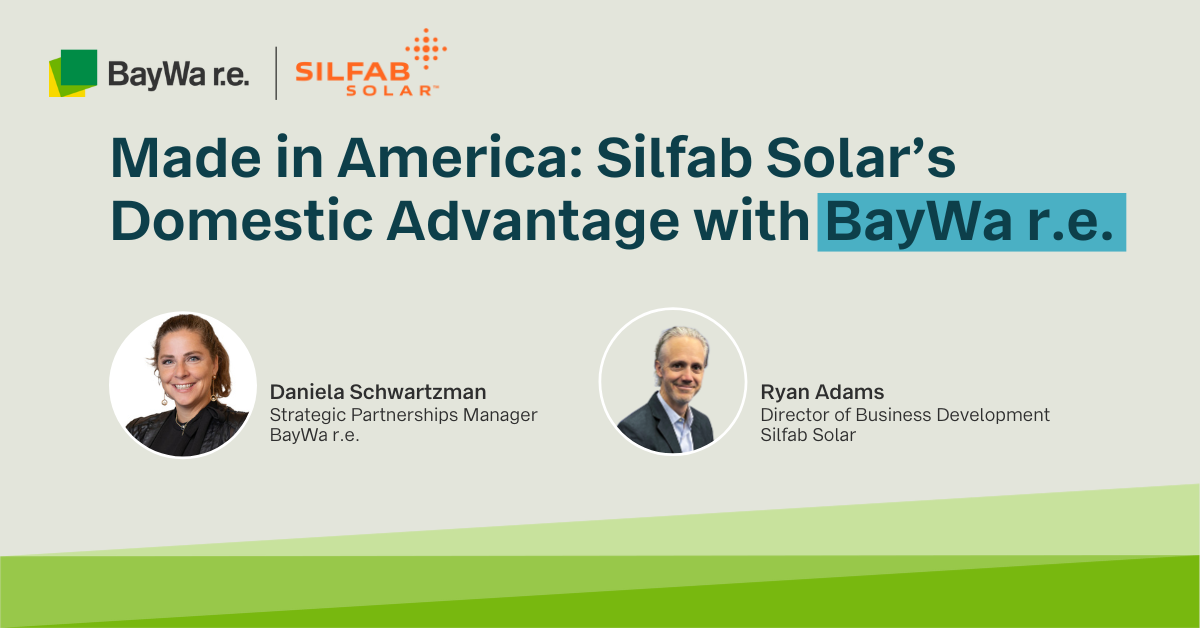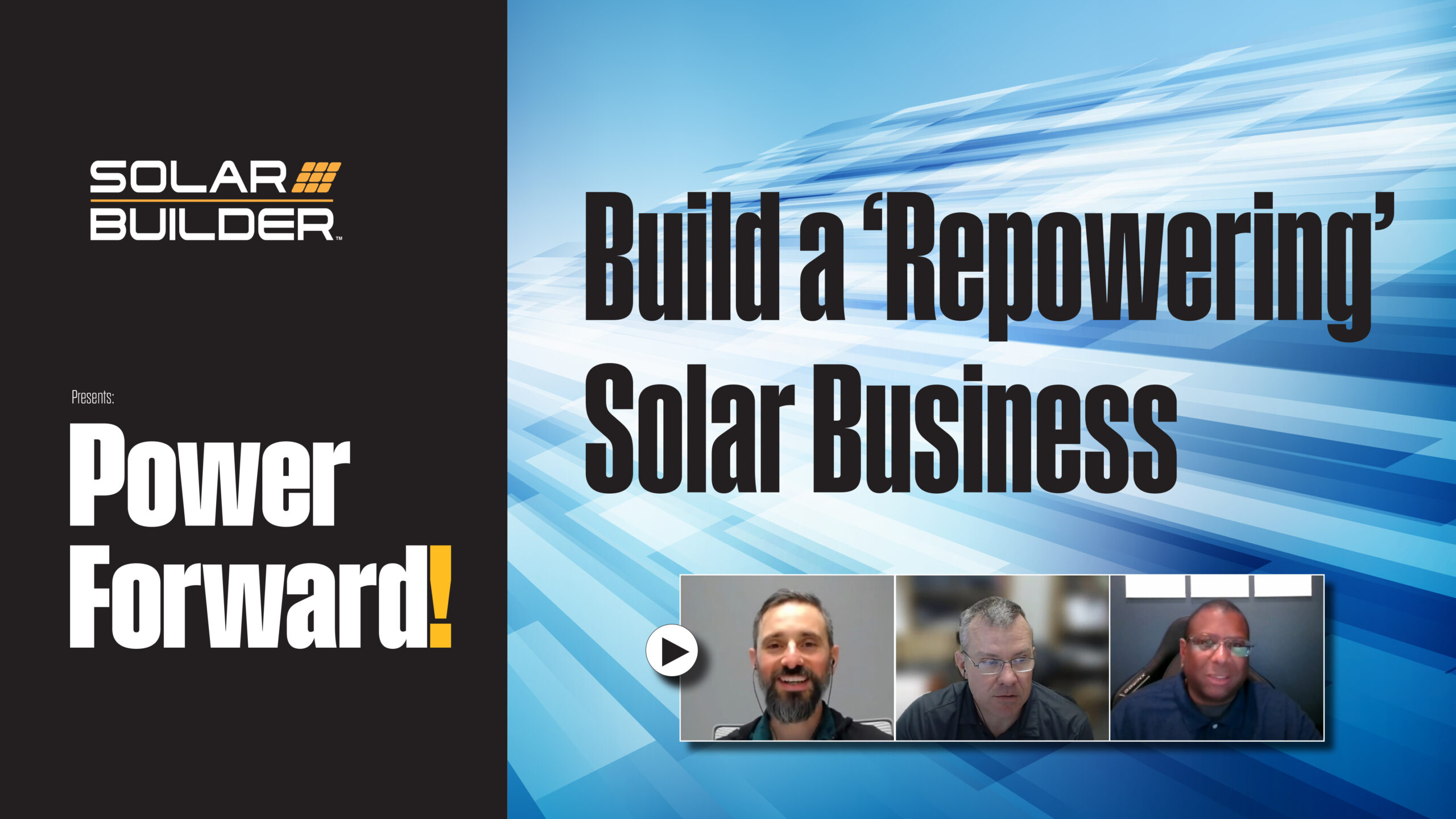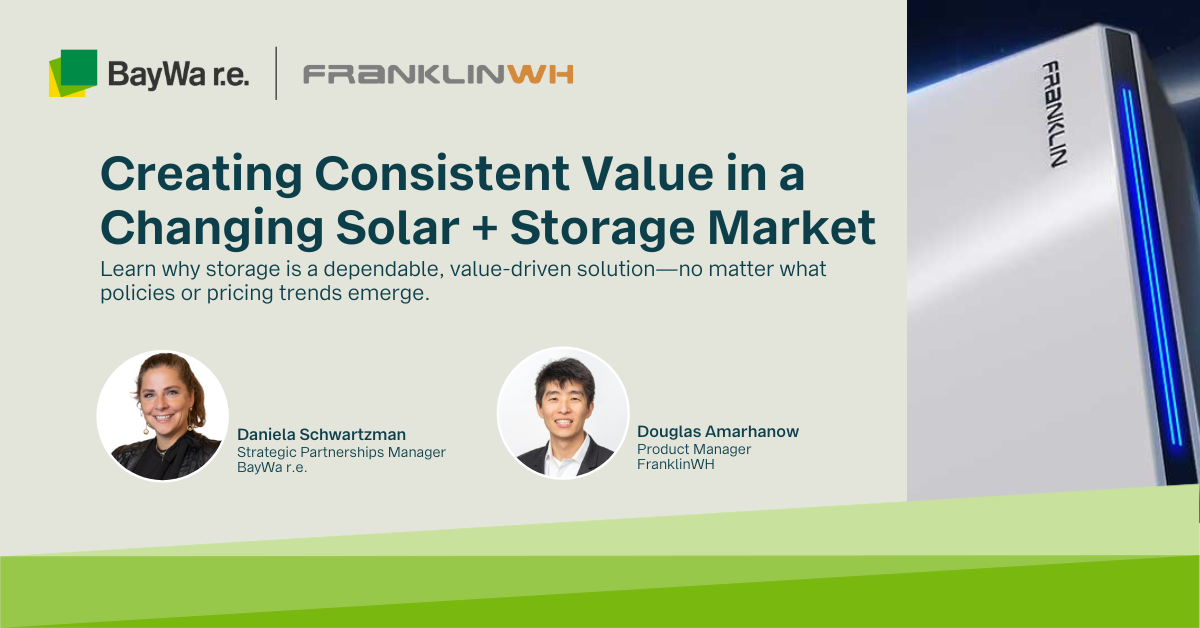Solar is growing so quickly, with many installers are asking themselves, “How do I scale my business? How do I make sure my company does not miss out?” And one question that often comes up in these discussions is: should we consider getting outside help for sales origination?
The ins and outs of working with sales originators, third party sales organizations, and sales channel partners was the focus of our Solar Town Hall live show on February 24. Our industry expert speakers covered everything including when and whether to consider third party sales; how to position your installation business to attract quality sales partners; pitfalls and nuances of setting contracts and relationships with sales originators; and weighing risks to profit margins and homeowner satisfaction.
Looking for best-in-class products, service, and a partner you can count on?
Meet our expert guests, then scroll down for our show recap. And be sure to share our video and podcast with your solar team!
Valarie Serrato, Vice President of Residential Business at Sunworks, Inc.
James Lee, Director of Enterprise Partnerships and Partner Development at Sunnova Energy Corp.
Bryan White, Research Analyst at Wood Mackenzie Power & Renewables
Rachel Schapira, Director of Residential Finance at BayWa r.e. Solar Systems (USA)
Solar Sales Originators: Potential Payoffs—With Proper Preparation
A primary driver behind why solar contractors consider third party sales is to capture more market share. By selling through a network of channel partners, contractors can broaden their reach and get their products and services out in front of more potential customers — potentially a broader audience than may be achievable by an in-house team sales team, says Valarie Serrato, Vice President of Residential Business at Sunworks, Inc. “I think that companies are looking at different options, especially since the COVID environment has made it somewhat difficult to obtain sales,” said Serrato. “Being creative is what will make your company successful.”
Another goal behind why solar contractors might use these sales organizations is to expand into new geographies and offer new products, says Bryan White, Research Analyst at Wood Mackenzie Power & Renewables, and a returning Solar Town Hall guest. But installers are trying to decide how much of this process to take on in-house versus outsourcing to a third party. “A big reason that this is such a hot topic is we all know how high of a cost customer acquisition can be,” said White. “It’s obviously a huge portion of the cost stack. It can be a lot of work and effort and very capital intensive to invest in internal sales teams. It can also be expensive to partner with some of these organizations as well — but it comes down to cost / benefit.”
Customer acquisition costs differ widely depending on the size of the contractor and the sales approaches being implemented. Tesla represents the outlier on the high end — averaging more than $1/watt, since it’s expensive to maintain both a national presence and to be knocking on doors. “Mid-size and larger regional contractors can sometimes see between 75 cents/watt to $1/watt in costs. Whereas small contractors – I’ve seen reports of costs of 50 cents/Watt or even lower,” said White. Again, that range depends on the different approached to customer acquisition.
Decide How You Want to Grow — Have a Reason Why You Need Sales Help
Of course, sales organizations exist because they’re experts in sales — it’s a skill and service their business have invested in. For solar businesses who don’t have that expertise, strategic partnerships with these sales channel partners can help. But ultimately, deciding whether to invest in in-house sales or third-party sales depends on what you’re capable of and what you’re prepared for as a business, said James Lee, Director of Enterprise Partnerships and Partner Development at Sunnova Energy Corp. “I know many contractors who are satisfied with where they are… and then there are some that want to grow and become a bigger player,” said Lee. “If you have certain strategies that encompass high growth / high revenue, scaling to a point where you want your business at a certain level — partnering with great sales organizations is going to help you get there a lot quicker than trying to scale the salesforce yourself.”
Nor is the sales investment question an either-or situation. Valarie Serrato cites Sunworks’ own strategy of having a dual-model, being a large corporation capable of balancing the advantages of an in-house sales team plus sales channel partners. “Figuring out that business model and your agenda will really determine which method or hybrid of methods works best for you,” recommended Serrato. “For us, it’s really about territory and region. I have in-house sales attacking one certain region and territory, and then my sales channel partnerships helping with the growth and expansion of the company. Really set clearly what your expectations are for each group — then again, making sure that your business model, agenda, and mission supports both.”
“For us, it’s really about territory and region. I have in-house sales attacking one certain region and territory, and then my sales channel partnerships helping with the growth and expansion of the company. Really set clearly what your expectations are for each group — then again, making sure that your business model, agenda, and mission supports both.”
— Valarie Serrato, Vice President of Residential Business at Sunworks, Inc.
Managing Misunderstandings and Perceptions of Risks and Benefits
One caution: watch your margins. There’s an assumption that by splitting off some, or all, sales processes to outside organizations a contractor’s business costs will decline. “There is margin compression that can happen with the dual-model. Because instead of having one company needing to take profit from a sale to a homeowner, now you have two companies or potentially three,” said Rachel Schapira, our own Director of Residential Finance at BayWa r.e. Solar Systems. As installers negotiate arrangements with sales organizations, both parties should take extra care to clearly define how profits and costs are shared and assigned, and avoid uneven contracts. “Solar installation is a fairly tight-margin industry, especially if you compare it to a lot of other types of businesses out there,” noted Schapira.
Your perception of benefits matter, explained Valarie Serrato — and contractors should remember that even if you take your sales outside, you still have to devote resources to manage that sales partner. “That does take infrastructure — that does take additional team members,” reminded Serrato. Similarly, contractors also have to weigh whether an outside company — who might simply do what’s best for themselves or promote equipment they perceive as easier to sell — will provide better or similar benefits in terms of reliable leads and sales projections to plan their business around, compared with the commissions involved.
Contractors and sales partners also need to be clear about who owns the risk when there are missed expectations on the part of homeowners, added Rachel Schapira. If customer expectations are not met on a contract — or if there’s a miscommunication over what is promised by the sales originator at the kitchen table — the contractor could be the one left holding the bag and the bad Yelp reviews. “Some EPC’s negotiate to share some of the risks, or to move some of the risk over to the originator, depending on how that’s arranged,” suggested Schapira. “I think a lot of people are not budgeting for the risk of how you manage or how you resolve situations for homeowner expectations are not met.”
The benefits of outside sales partnerships are what you make of them. Bryan White of Wood Mackenzie cites other tag-team approaches. “Maybe there’s a situation where, internally, you’re struggling to generate sales based on where you’re focused. And while that’s drying up, you have a third-party organization helping you out to funnel through opportunities to keep your business going,” suggested White. Or, contractors can choose to farm out specific segments of the sales process for third parties to specialize in, with the originator more involved in lead generation and appointment setting. “But then, once that appointment is set, it gets transferred to the contractor, which then closes the sale,” explained White. “Some folks might say that there’s some inefficiency in divvying up that process, but I think you’re also seeing some good synergy.”
Finding Your Dance Partner Takes Work
All that said, contractors should remember that third party sales organizations won’t just partner with any installer. Sales organizations, too, are taking a leap of faith with an installer partner, so they are looking for companies who are primed for success.
“Do you have the proper tools and services in place? Do you have the right financing partners already on your platform to offer a sales org? Do you have a certain software design service?” asked James Lee of Sunnova. “If you don’t have the infrastructure built to support sales orgs from the get-go, it’s going to be very difficult to attract the sales orgs — and convince them that you’re the right partner for them.” Attracting these sales partners can also include having a Yelp page, a good website, and having tools that their sales originator can use to push your company forward, added Valarie Serrato of Sunworks. “It’s really asking yourself: Why is your company different than the other companies? That differentiator is something a sales organization can use to sell your company, not just product or price,” explained Serrato.
As for where to find reputable sales channel partners, both James Lee and Valarie Serrato recommend rolling up your sleeves and tapping into your industry and individual networks. Attend those virtual industry conferences and events, because sales organizations reps are attending those town halls and panels as well. “Utilizing your network to really start reaching out and letting people know, ‘Hey, I’m here. This is my business,’” suggested James Lee. “That’s the great thing about this industry is you can always have a conversation around your business — and people want to learn more about you.”
Likewise, LinkedIn can be a great scouting tool. “Utilize your LinkedIn to find sales originators. Reach out to see who’s out there, what they’re doing — and ask questions,” said Serrato. “LinkedIn is a very useful tool for connecting — and you attract them by your branding, your name, your ability to put a foundation around it, and your confidence level.”
Onboarding a Successful Sales Partnership
Our Solar Town Hall industry guests walked us through a variety of pitfalls and questions that solar contractors should be mindful of when establishing their sales partnership:
Before Saying “I Do”: If you’ve identified a sales channel partner, make sure you check them out for legitimacy. Do they have licenses and insurance in place, and other requirements by your state and JHA? Do your homework and look up their reviews on Better Business Bureau, Yelp, or from industry colleagues. Ask yourself if their leadership, company culture, and sales ethics match with that of your own business.
How Will This Be Done: Be transparent and communicate how this partnership is going to work. Understand their sales strategy. How do they communicate with the homeowner, and using what tools? How will you as a contractor be protected from risk of miscommunication and homeowner dissatisfaction? How will the homeowner and your finance partners be protected from poor sales ethics?
Access to Shared Tools and Rules: Make sure that the sales partners have access to training materials for the solar financing tools and platforms you have available to offer. Provide materials and trainings on your company’s expectations of what you will and won’t allow. Set limitations on materials, installations, and roof types you don’t like to install on — even geographic limitations on distance of projects from company hub. Communicate the rules and limitations set by your financiers on price caps and capital costs.
Homeowner Handling Responsibilities: Decide who is better at what, in terms of homeowner interactions and communicating progress to the customer. Some sales organizations prefer to control the entire homeowner communication from front to end; others handoff to the installer to take things all the way until commissioning.
Catching Gaps in the Contract and in Homeowner Expectations: Make your own checklist. Check over and over the contract for any errors, problems, and differences between your expectation and that of the sales organization. And even after the contract has been signed, find ways to gage the homeowner’s understanding of expectations (insert relevant questions in your paperwork, in conversation, etc.), so that any concerns can be taken back to the sales partner.
Encouraging Words for Your Sales Partnership Exploration
When it comes to sales originators, third party sales organizations, and sales channel partners, our panelists agreed that at the end of the day the most important question is, “What’s right for your business?”
In closing, our guests reminded our solar installer community to do their homework. Don’t make assumptions when exploring a third-party sales partnership. Talk to other installers who have worked with sales channel partners. Know how homeowner expectations will be communicated and managed. Make sure that technology platforms from design to financing to communication are compatible between you and your sales partner. Look out for any expectations or constraints set by your solar financier. And be very intentional about your business mission, vision, and plan — and why you want to bring out sales partners to begin with.
“Really weigh out your options from a business and financial perspective — keeping your goals for the future in mind and understand what each model brings to the table with cost versus control,” as Valarie Serrato aptly explained. “Then just knowing the pivot if something’s not working.”
Thank you all again for participating in our Solar Town Hall events and being part of our #SolarFam! RSVP and tell a colleague — we’ll see you online February 24 for this important discussion.
Missed one of our events? Access all of our expert roundtables in our Solar Town Hall archives, find video excerpts on YouTube, and take podcast versions with you on the go via Spotify, Apple, or Google.
BayWa r.e. Solar Systems LLC supplies residential and commercial solar installers in the United States with quality solar + storage components, forecasting, business planning advice, and a community of experts. Visit www.solar-distribution.com to read our industry insights articles and stream our Solar Tech Talk and Solar Town Hall podcasts on YouTube and Spotify. Follow us on LinkedIn, Twitter, and Facebook to stay connected. Ask us about our Split Pay financing program and use our industry-leading Webstore to save time, get gear shipped, and get jobs done! Part of the BayWa r.e. Global family of renewable energy companies.
Subscribe to our newsletter
Stay up to date on the latest industry news, new product releases, BayWa r.e. news and more when you subscribe to our monthly newsletter.




